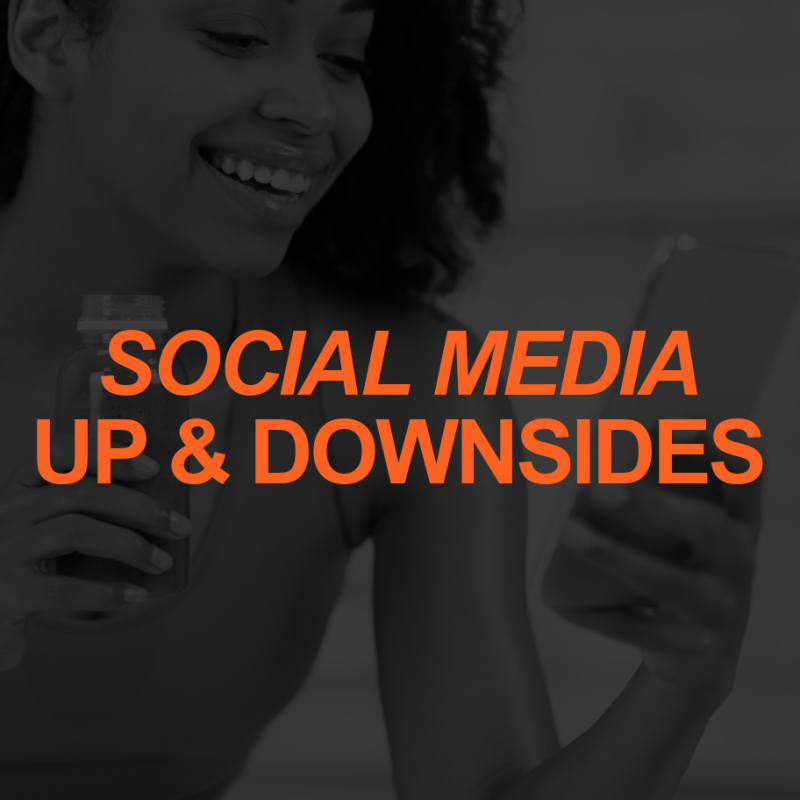
Oh, social media, how I love and despise you in equal measure. Social media provides just as many benefits as it does barriers or downsides. Let’s take a closer look at them both.
Social Media Upsides
We would be misguided if we neglected to acknowledge the number of positives associated with the many social media platforms available to us. When used appropriately and intentionally, social media offers unique benefits to use as health and exercise professionals – and as individuals.
First, connectedness and reducing the transactional distance between us and our consumers and clients. Transactional distance is the extent to which time and distance impact communications and interactions in a virtual experience. This is most often referenced in the instructional design world, but it is applicable to us as health and exercise professionals because we are also educators – designers – coaches. Social media allows us to close the distance and interact with our consumers frequently and in fun and innovative ways (educational content, WOD, EOD, memes, reels, chats, etc.).
Second, content. The content we create engages the audience with us and our brand/professions.
Third, social media provides multiple platforms we can use to increase our visibility. And – let’s not forget – it is FREE. Gone are the days of newspaper advertisements (I’m probably revealing my age referring to this type of print media).
Other advantages include education, communication, and sharing of your expertise and niche knowledge. Social media is a great way to learn from other industry professionals. I personally love to follow respected registered dietitians, trainers, coaches, and motivating individuals. I draw inspiration from their content. It is also a way to support their work and industry contributions.
We also cannot deny the value of the quick and easy communication tools social media offers. This is often a bonus for clients (and for us).
Finally, we can easily and consistently share the expertise we have. We can showcase our work, celebrate accomplishments, and share our journeys with each other and our clients.
Despite the benefits, there are what I like to call the “orange caution cones” of social media.
Downsides of Social Media
Social media offers as many reasons to operate as it does to engage.
First, it is time-consuming. How many of you ever checked Instagram and experienced the “Time Warp”? You think you spent two minutes scrolling and suddenly 30 minutes of your day is now gone! Not only is it time-consuming to check media – it is time-consuming to create thoughtful content and post it consistently.
Second, there’s a distraction factor. There are just some messages that are not useful, supportive, or valuable. They are either negative, full of falsehoods, or simply annoying.
Third, there is an element of inauthenticity, depending on the content being published, (here’s where the influencers are big – they have the unrealistic nature of content down to a “science” – which is really the only science fit-fluencers seem to understand).
Other disadvantages or cautions relate to the emotional dimension. We know with asynchronous communication, nonverbals, and emotional cues are hard to discern and are sometimes entirely absent. This can be a roadblock.
Next, social media is not always a safe space. It is extremely easy for individuals to “hate” or spend their time criticizing others for their journey or their ways. This is not useful or growth-promoting.
Lastly, social media sometimes presents demotivating messages and images that divide the consumer from their desires. Think about the scantily clad ”trainer” promoting a 20-minute “booty burn” that makes the consumer think:
a) they can achieve the same level of physique in those 20-minute workouts and/or
b) creates in the mind of the consumer a sense of failure because they are unable to achieve what is truly inauthentic, enhanced, and unrealistic. This begs the question, what does the research say about this?
Balancing the Equation
Take the above information and perspective and use it to calculate how you spend your own time on social media–whether for business or personal reasons–and carefully consider how this realm may also be impacting your clients. Imagine how much your client may be consuming and internalizing with regard to images and information on social media. Say she mentions an influencer she follows or perhaps shows you a workout “plan” advertised on someone’s account and wants you to program it for her.
How might you respond? Or might it be worth it to talk about these issues proactively and address potential barriers that may never be verbalized if you don’t specifically confront the up and downsides of social media with your clients?
And then reflect the potential influence that the social media experience may be having on your own mindset and business practices. Are they positive influences challenging you to grow or do you find yourself comparing yourself needlessly and losing confidence in your abilities? Use your time wisely and make sure you check in with yourself, regularly assessing how your time is managed and how positive your frame of mind is. As long as your social media experience is reaping rewards of some kind, it’s worth balancing the downsides with some conscientiousness.
References
Carrotte, E.R., Vella, A.M.., & Lim, M.S.C. (2015). Predictors of “liking” three types of health and fitness-related content on social media: A cross-sectional study. Journal of Medical Internet Research, 17, 8, 205.
Deighton-Smith, N. & Bell, B.T. (2018). Objectifying fitness: A content and thematic analysis of #fitspiration images on social media. Psychology of Popular Media Culture, 7, 4, 467–483.
Raggatt, M. et al. (2018). “I aspire to look and feel healthy like the posts convey”: Engagement with fitness inspiration on social media and perceptions of its influence on health and wellbeing. BMC Public Health, 18, 1002.
Vogel, A. (2018). Does the fitness industry have a body image problem? https://www.ideafit.com/personal-training/does-the-fitness-industry-have-a-body-image-problem/





